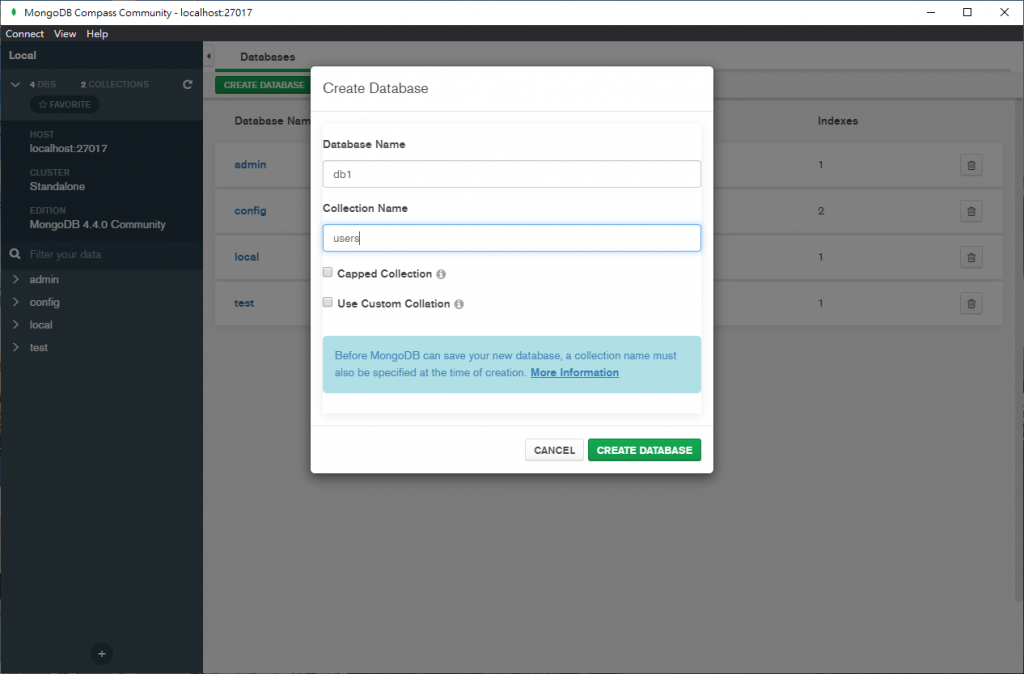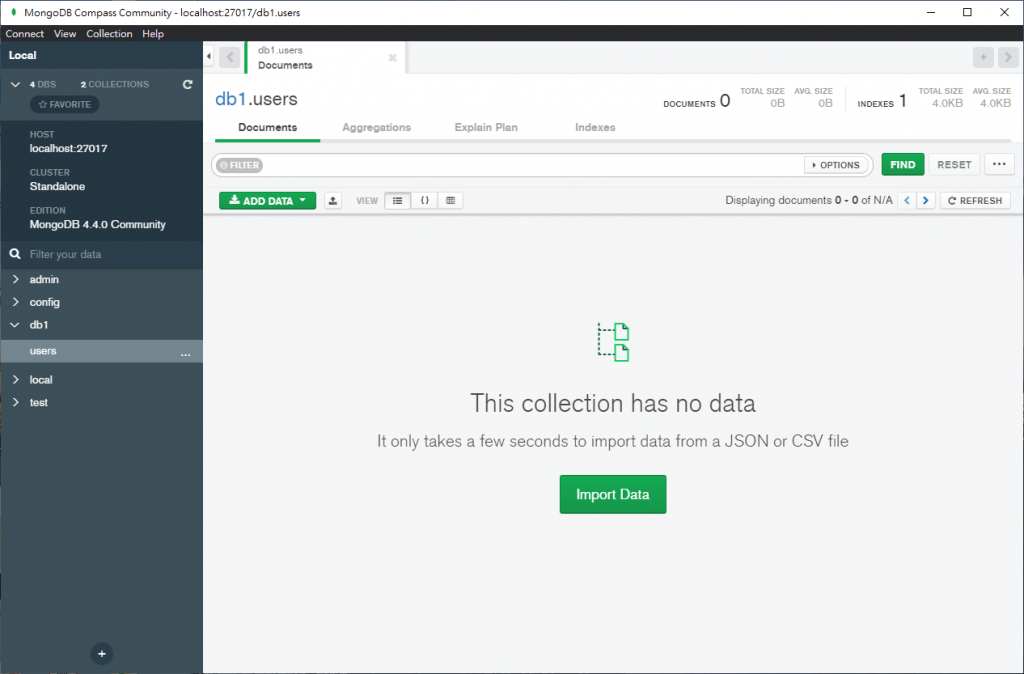
在安裝 MongoDB 後,來看看要如何使用 Deno 串接 MongoDB 吧!
繼昨天的安裝教學,我們現在來建立待會要使用的 database 以及 collection :
Create Database 。


deno_mongo 是一款 MongoDB 資料庫驅動的 Deno 第三方套件,它是基於 rust 官方的 mongoldb Library 所打造的。
在開始之前,需要將第三方模組引入:
import { MongoClient } from "https://deno.land/x/mongo@v0.13.0/mod.ts";
引入後,將 MongoClient 物件實例化:
const client = new MongoClient();
開啟 MongoDB 後,就可以使用 client 建立連線:
client.connectWithUri("mongodb://localhost:27017");
執行到這一步時,就已經成功連上 MongoDB 了,不過我們還沒告訴 Deno 要存取資料庫中的哪一個 database 和 collection :
const db = client.database("test");
const users = db.collection("users");
上面的範例是讓 Deno 連上 MongoDB 中 test database 的 users collection 。
使用 Interface 可以有效預防有心人士在 json 格式內插入不需要的資料。
假設我們預期 collection 的欄位只有 id 、 username 以及 password ,可以先定義好 interface :
interface UserSchema {
_id: { $oid: string };
username: string;
password: string;
}
定義好後,我們在連結 collection 的那行程式碼加入 interface 檢查:
const db = client.database("test");
const users = db.collection<UserSchema>("users");
在學會如何與 MongoDB 建立連線後,跟著筆者一起看看 deno_mongo 提供的操作方法吧!
注意!進行以下常見操作都需要先將 Deno 與 MongoDB 做連接唷!
import { MongoClient } from "https://deno.land/x/mongo@v0.13.0/mod.ts"; const client = new MongoClient(); client.connectWithUri("mongodb://localhost:27017"); const db = client.database("test"); const users = db.collection("users");
const insertId = await users.insertOne({
username: "user1",
password: "pass1",
});
const insertIds = await users.insertMany([
{
username: "user1",
password: "pass1",
},
{
username: "user2",
password: "pass2",
},
]);
const user1 = await users.findOne({ _id: insertId });
const all_users = await users.find({ username: { $ne: null } });
計算 Collection 中有多少筆資料包含使用者輸入的鍵值對 :
const count = await users.count({ username: { $ne: null } });
聚合操作主要用於處理數據 (像是:取平均值、加總等操作)並回傳計算後的結果。
const docs = await users.aggregate([
{ $match: { username: "many" } },
{ $group: { _id: "$username", total: { $sum: 1 } } },
]);
const { matchedCount, modifiedCount, upsertedId } = await users.updateOne(
{ username: { $ne: null } },
{ $set: { username: "USERNAME" } }
);
const { matchedCount, modifiedCount, upsertedId } = await users.updateMany(
{ username: { $ne: null } },
{ $set: { username: "USERNAME" } }
);
const deleteCount = await users.deleteOne({ _id: insertId });
const deleteCount2 = await users.deleteMany({ username: "test" });
我們可以使用 skip() 跳過指定數量的資料:
const skipTwo = await users.skip(2).find();
如果使用者需要在 MongoDB 中找尋數據並指定數據記錄的數量,可以使用 limit() :
const featuredUser = await users.limit(5).find();
最後要注意的是, deno_mongo 目前還不穩定,使用上不要忘記加入 --unstable 標籤唷!
deno run --allow-net --allow-write --allow-read --allow-plugin --allow-env --unstable yourCode.ts
今天我們學會了使用第三方套件去連線 MongoDB 。明天筆者就會將超簡易 WebAPI 留下的坑填完,順便分享一下什麼是 ORM ,我們明天見!
此外,本篇所使用的範例程式碼參考了 deno_mongo 的官方文件,請知悉。
